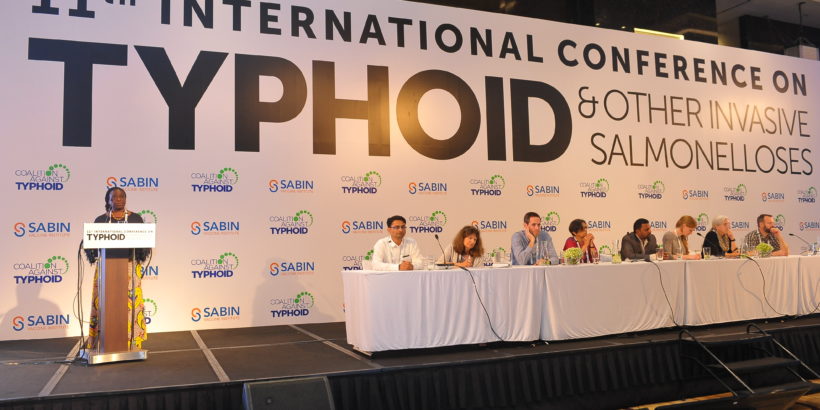We’ve recently returned from the 11th International Conference on Typhoid and Other Invasive Salmonelloses, the gathering hosted by the Coalition against Typhoid (CaT) every two years. CaT was thrilled to host more than 400 attendees for in-depth discussions focused on typhoid, paratyphoid, and invasive non-typhoidal salmonella disease. Reflecting the surge of interest in enteric fever, the conference showcased more data than ever before. Along with presentations from seasoned experts in the field, we were pleased to note that a high number of presentations were delivered by young researchers and practitioners at the local level – many of whom were presenting at a scientific conference for the first time.
Dr. Kathleen Neuzil, Director of the Center for Vaccine Development and Global Health at the University of Maryland School of Medicine and Principal Investigator of the Typhoid Vaccine Acceleration Consortium (TyVAC) offered a sobering reminder in the opening keynote that “rather than becoming a disease of the past, typhoid has become a disease of the poor.” Encouragingly, on the second conference day, the TyVAC team showed positive results from their typhoid conjugate vaccine (TCV) efficacy trial in Nepal, giving us hope that speedy roll-out of the new vaccine could make a rapid impact in disease incidence.
Underscoring the urgency of typhoid control measures, we also saw worrisome data on the growing problem of drug resistance. The Surveillance for Enteric Fever in Asia Project has found ceftriaxone resistance is rapidly increasing in Pakistan, and researchers are now finding 50% or more cases of typhoid are extensively drug-resistant. Dr. Senjuti Saha, a scientist at the Child Health Research Foundation in Bangladesh, noted that we are only one point mutation away from azithromycin resistance and extremely drug resistant typhoid in Bangladesh. As Dr. Jacob John, professor at Christian Medical College Vellore, pointed out, we cannot afford to wait for typhoid to become extremely drug resistant before we scale-up prevention and control efforts – the cost in human lives will be too great.
We must work quickly and in coordination to roll out the TCV. Knowing that vaccines are most effective when paired with other solutions, we have to embrace an integrated control approach that recognizes the importance of clean water in typhoid prevention. Dr. Om Prasad Gautam, Hygiene Technical Support Manager at WaterAid, suggested that every vaccine introduction strategy should have an accompanying strategy to address water, sanitation and hygiene improvements.
While all were optimistic about our progress, we acknowledged that we have decades to go until typhoid is truly a disease of the past. However, even in the face of remaining data gaps, as Dr. Jeff Stanaway, Assistant Professor at the Institute for Health Metrics and Evaluation at the University of Washington, noted, we cannot let uncertainty justify inaction.
At the close of the conference, we discussed the path toward elimination. We know enough to move forward with typhoid prevention and control, integrating both the TCV to drive short-term impact and infrastructure improvements for long-term prevention. Now is the time to invest in water and sanitation infrastructure. As global climate shocks threaten water supplies around the world, communities are at increased risk of water-borne diseases. An intermittent water supply is an inherently leaky water supply, and carries the possibility of contamination. This is an engineering problem as well as a health problem, and requires a diverse team to develop innovative approaches. As Dr. Steve Luby, Professor of Medicine at Stanford University, encouraged conference attendees, “take an engineer to lunch!”
Now, we hope this gathering will energize and advance the fight against enteric fever at the local level, building on the incredible global response to typhoid that we have seen from the WHO and Gavi, the Vaccine Alliance during the past two years. We have much work to accomplish, and must embrace a multisector effort to accelerate progress. It is time to expand our community to bring in the local implementers, healthcare practitioners, and the WASH community, including district water authorities. Only with a diverse approach will we have a strong team to take on typhoid and propel us forward toward elimination.
In the meantime, remember that the Take on Typhoid partnership and the Coalition against Typhoid remain a resource for this community. We are here to make sure you all stay connected and to help coordinate the fight against typhoid and other invasive salmonelloses.



